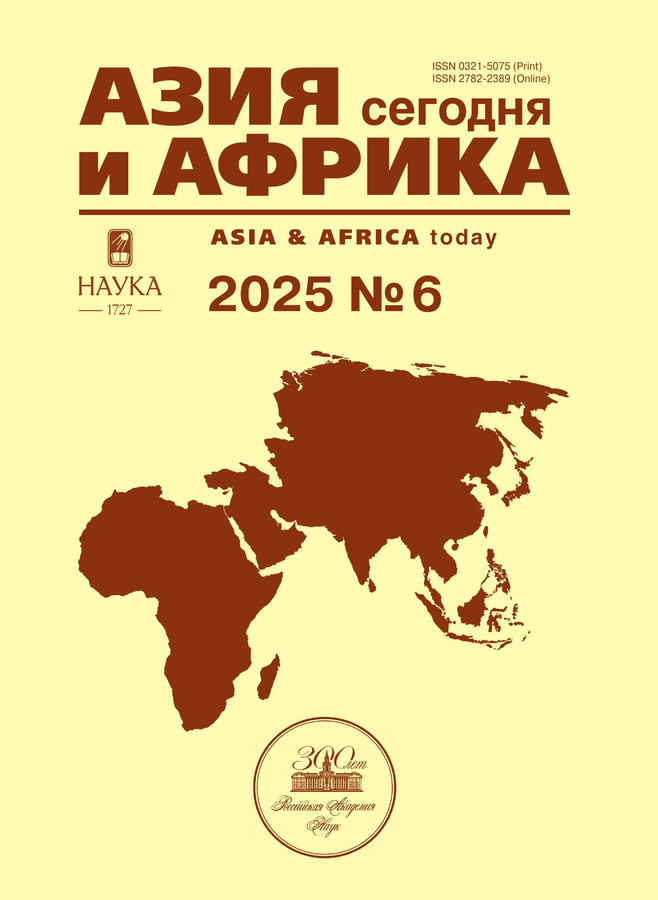China’s Digital Silk Road: Opportunities and Risks for Developing Countries
- 作者: Voytikov K.N1
-
隶属关系:
- Lomonosov Moscow State University
- 期: 编号 6 (2025)
- 页面: 70-77
- 栏目: Post-graduate tribune
- URL: https://rjonco.com/0321-5075/article/view/685411
- DOI: https://doi.org/10.31857/S0321507525060081
- ID: 685411
如何引用文章
详细
The Digital Silk Road (DSR) is an integral part of the One Belt and One Road Initiative first proposed by China’s President Xi Jinping in 2013. Currently the goals of the DSR include inclusive economic growth, contribution to the achievement of UN Sustainable Development Goals and construction of the community with common interests and a common future in cyberspace. DSR includes several areas of cooperation between countries such as digital interconnectedness, development of cross-border e-commerce, digitalization of the economy, creation and proliferation of technical standards and addressing issues of cybersecurity and cyber sovereignty. For participating countries, DSR presents unique opportunities, which enable them to bridge digital divide and ensure domestic economy modernization, but also imposes risks related to cybersecurity, data privacy and protection and emergence of technological dependency on China. This study is devoted to analyses of respective risks and opportunities and development of state policy recommendations regarding developing countries DSR participation. Policy recommendations are aimed to deliver, on the one hand, the most favorable economic effect and, on the other hand, to mitigate risks identified in the research.
作者简介
K. Voytikov
Lomonosov Moscow State University
Email: konstantin.voytikov@gmail.com
Post-graduate student, Department of Oriental Political Studies, Faculty of Global Studies Moscow, Russia
参考
- Agbebi M., Xue G., Yu Z. China-powered ICT infrastructure: Lessons from Tanzania and Cambodia. African Perspectives Global Insights Policy Briefing. 2021. Vol. 252.
- Beijing Initiative on the Belt and Road International Digital Economy Cooperation. Ministry of the Foreign Affairs of the People’s Republic of China. https://www.mfa.gov.cn/eng/zxxx_662805/202310/P020231020460592932463.pdf (accessed 05.03.2024)
- Cheney C. China’s Digital Silk Road: strategic technological competition and exporting political illiberalism. Issues & Insights, Working Paper WP8, Vol. 19. Pacific Forum. 2019. https://pacforum.org/wp-content/uploads/2019/08/issuesinsights_Vol19-WP8FINAL.pdf (accessed 10.03.2024)
- Gagliardone I. China, Africa, and the Future of the Internet. London: Zed Books, 2019. 192 p.
- Гамза Л.А. Цифровой Шёлковый путь Китая. Проблемы Дальнего Востока. 2022. Вып. 2. С. 63–79. doi: 10.31857/S013128120019578-6
- Gamza L.F. 2022. China’s Digital Silk Road. Far Eastern Studies. Iss. 2. Pp. 63–79. (In Russ.). doi: 10.31857/S013128120019578-6
- Heeks R., Ospina A.V., Foster C., Gao P., Han X., Jepson N., Schindler S., Zhou Q. China’s digital expansion in the Global South: Systematic literature review and future research agenda. The Information Society. 2024. Vol. 40. Iss. 2. Pp. 69–95. doi: 10.1080/01972243.2024.2315875
- Hernandez K. Achieving complex development goals along China’s Digital Silk Road. K4D Emerging Issues Report. Brighton, UK: Institute of Development Studies, 2019. 43 p.
- Kliman D., Grace A. Power Play. Washington: Center for a New American Security. September 2018. 39 p.
- Seaman J. China and the new geopolitics of technical standardization. Notes de l’Ifri. 2020. Vol. 34. Pр.1–34.
- Segal A. China’s alternative cyber governance regime. Council on Foreign Relations. March 13, 2020. https://uscc.gov/sites/default/files/testimonies/March%2013%20Hearing_Panel%203_Adam%20Segal%20CFR.pdf (accessed 27.03.2024)
- Sen G., Bingqin L. The digital silk road and the sustainable development goals. IDS Bulletin. 2019. Vol. 50. № 4. Pp. 23–46. doi: 10.19088/1968-2019.137
- Teng Kang. Economic impact of Internet and information development on countries along the Belt and Road Route. Journal of Physics: Conference Series. IOP Publishing. 2020. Vol. 1533. № 2. P. 022107. doi: 10.1088/1742-6596/1533/2/022107
- Triolo P., Allison K., Brown C., & Broderick K. The Digital Silk Road: Expanding China’s Digital Footprint. Eurasia Group. April 8, 2020. https://eurasiagroup.net/files/upload/Digital-Silk-Road-Expanding-China-Digital-Footprint1.pdf (accessed 24.03.2024)
- Vila Seoane M.F. Chinese and U.S. AI and Cloud Multinational Corporations in Latin America. Towards an International Political Economy of Artificial Intelligence. Ed. by Keskin T., Kiggins R.D. (eds). International Political Economy Series. Palgrave Macmillan, Cham. 2021. Pp. 85–111. doi: 10.1007/978-3-030-74420-5_5
- Vision And Actions On Jointly Building Silk Road Economic Belt And 21st-Century Maritime Silk Road. Belt and Road Portal. March 30, 2015. https://eng.yidaiyilu.gov.cn/p/1084.html (accessed 20.03.2024)
- Xi Jinping. Full text of President Xi’s speech at opening of Belt and Road forum. Belt and Road Portal. May 14, 2017. https://eng.yidaiyilu.gov.cn/p/13299.html (accessed 23.03.2024)
- Zhou Taidong, Xue Qi. The Digital Silk Road and Southeast Asian Countries. The Fourth Industrial Revolution and the Future of Work: Implications for Asian Development Cooperation. Ed. by Anthea Mulakala. Sejong-si: KDI School of Public Policy and Management. December 2020. Pp. 132–164.
补充文件









